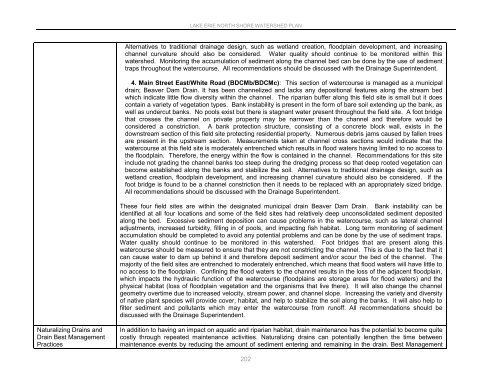Lake Erie North Shore Watershed Plan - Niagara Peninsula ...
Lake Erie North Shore Watershed Plan - Niagara Peninsula ...
Lake Erie North Shore Watershed Plan - Niagara Peninsula ...
You also want an ePaper? Increase the reach of your titles
YUMPU automatically turns print PDFs into web optimized ePapers that Google loves.
LAKE ERIE NORTH SHORE WATERSHED PLAN<br />
Alternatives to traditional drainage design, such as wetland creation, floodplain development, and increasing<br />
channel curvature should also be considered. Water quality should continue to be monitored within this<br />
watershed. Monitoring the accumulation of sediment along the channel bed can be done by the use of sediment<br />
traps throughout the watercourse. All recommendations should be discussed with the Drainage Superintendent.<br />
4. Main Street East/White Road (BDCMb/BDCMc): This section of watercourse is managed as a municipal<br />
drain; Beaver Dam Drain. It has been channelized and lacks any depositional features along the stream bed<br />
which indicate little flow diversity within the channel. The riparian buffer along this field site is small but it does<br />
contain a variety of vegetation types. Bank instability is present in the form of bare soil extending up the bank, as<br />
well as undercut banks. No pools exist but there is stagnant water present throughout the field site. A foot bridge<br />
that crosses the channel on private property may be narrower than the channel and therefore would be<br />
considered a constriction. A bank protection structure, consisting of a concrete block wall, exists in the<br />
downstream section of this field site protecting residential property. Numerous debris jams caused by fallen trees<br />
are present in the upstream section. Measurements taken at channel cross sections would indicate that the<br />
watercourse at this field site is moderately entrenched which results in flood waters having limited to no access to<br />
the floodplain. Therefore, the energy within the flow is contained in the channel. Recommendations for this site<br />
include not grading the channel banks too steep during the dredging process so that deep rooted vegetation can<br />
become established along the banks and stabilize the soil. Alternatives to traditional drainage design, such as<br />
wetland creation, floodplain development, and increasing channel curvature should also be considered. If the<br />
foot bridge is found to be a channel constriction then it needs to be replaced with an appropriately sized bridge.<br />
All recommendations should be discussed with the Drainage Superintendent.<br />
These four field sites are within the designated municipal drain Beaver Dam Drain. Bank instability can be<br />
identified at all four locations and some of the field sites had relatively deep unconsolidated sediment deposited<br />
along the bed. Excessive sediment deposition can cause problems in the watercourse, such as lateral channel<br />
adjustments, increased turbidity, filling in of pools, and impacting fish habitat. Long term monitoring of sediment<br />
accumulation should be completed to avoid any potential problems and can be done by the use of sediment traps.<br />
Water quality should continue to be monitored in this watershed. Foot bridges that are present along this<br />
watercourse should be measured to ensure that they are not constricting the channel. This is due to the fact that it<br />
can cause water to dam up behind it and therefore deposit sediment and/or scour the bed of the channel. The<br />
majority of the field sites are entrenched to moderately entrenched, which means that flood waters will have little to<br />
no access to the floodplain. Confining the flood waters to the channel results in the loss of the adjacent floodplain,<br />
which impacts the hydraulic function of the watercourse (floodplains are storage areas for flood waters) and the<br />
physical habitat (loss of floodplain vegetation and the organisms that live there). It will also change the channel<br />
geometry overtime due to increased velocity, stream power, and channel slope. Increasing the variety and diversity<br />
of native plant species will provide cover, habitat, and help to stabilize the soil along the banks. It will also help to<br />
filter sediment and pollutants which may enter the watercourse from runoff. All recommendations should be<br />
discussed with the Drainage Superintendent.<br />
Naturalizing Drains and<br />
Drain Best Management<br />
Practices<br />
In addition to having an impact on aquatic and riparian habitat, drain maintenance has the potential to become quite<br />
costly through repeated maintenance activities. Naturalizing drains can potentially lengthen the time between<br />
maintenance events by reducing the amount of sediment entering and remaining in the drain. Best Management<br />
202
















